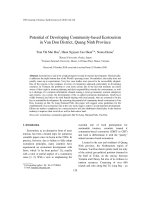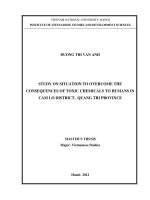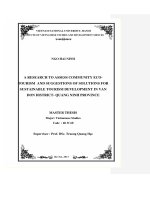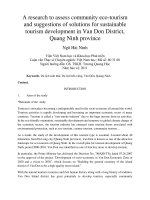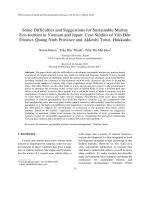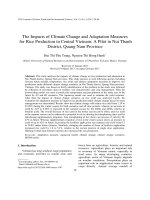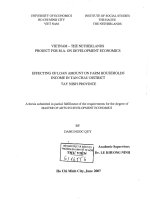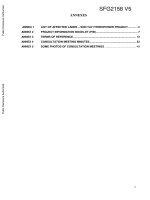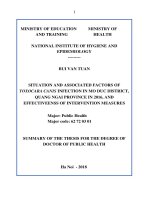Detecting changes in mangrove forests from multi-temporal sentinel-2 data in Tien Yen district Quang Ninh province
Bạn đang xem bản rút gọn của tài liệu. Xem và tải ngay bản đầy đủ của tài liệu tại đây (575.98 KB, 12 trang )
Management of Forest Resources and Environment
DETECTING CHANGES IN MANGROVE FORESTS
FROM MULTI-TEMPORAL SENTINEL-2 DATA IN TIEN YEN DISTRICT
QUANG NINH PROVINCE
Nguyen Quyet1, Nguyen Hai Hoa1*, Vo Dai Nguyen1, Pham Duy Quang1
1
Vietnam National University of Forestry
SUMMARY
Mangrove forests are intertidal wetlands and found along tropical, subtropical, and warm-temperate coastlines.
They also offer valuable ecosystem services. However, mangrove forests are especially vulnerable as typhoons
frequently hit during the monsoon season and under driving human pressures. The spatio-temporal change
information of mangrove forest cover distribution in Tien Yen district is incomplete. Thus, this study was
undertaken to detect spatial-temporal distribution of mangrove forests in Tien Yen district and then identify the
drivers of mangrove cover change. Multi-temporal Sentinel-2 data were used to detect changes in the extent of
coastal mangrove forests using the NDVI thresholds combined with the visual interpretation. Three land use and
land covers were categorised, namely mangrove forests, non-mangrove forests, and water bodies. Mangrove
forests in Tien Yen district were estimated to be 3133.8 ha in 2015 and decreased by 277.8 ha in 2020.
Aquaculture, shrimp farm and agriculture expansion, and other land uses were the main drivers for mangrove
deforestation during the period of 2015 - 2020. This study used the NDVI thresholds for coastal land covers
(NDVI value > 0.2 for mangrove forests). The overall accuracies assessments of land covers in 2020 (reached
91.3%, Kappa coefficient of 0.83) and land covers in 2016 (assessed at 88.3%, Kappa coefficient of 0.78) have
confirmed the effectiveness of using remotely sensed Sentinel-2A/B for monitoring the spatio-temporal changes
of mangrove forests in Tien Yen district.
Keyword: land use and land cover, mangrove forests, NDVI, Sentinel-2, Tien Yen district.
1. INTRODUCTION
Mangrove forests are defined as assemblages
of salt tolerant trees and shrubs that grow in the
intertidal regions of the tropical and subtropical
coastlines. They grow luxuriantly in the places
where freshwater mixes with seawater and
where sediment is composed of accumulated
deposits of mud. Mangrove forests are one of
the world's most diverse and active habitats, and
they are often distributed in the close to the
equator tropical and subtropical regions, where
the common pierce is submerged in sea water
(Thom, 1984). They are normally classified into
six types on the basis of the geophysical,
geomorphological and biological factors
(Thom, 1984). Mangrove forests are wellknown to control the shore by gathering
sediments from rivers and streams, which
reduce the movement of water. They also
protect and shelter coastal urban areas in from
the extreme weather occurrences, including
hurricanes and flooding (Ewel et al., 1998).
Mangrove forests are also able to filter toxins in
the environment biologically, such as CO2
emitted into the atmosphere by human activities
(Jennerjahn and Ittekkot, 2002; Dittmar et al.,
2006; Duke et al., 2007). One of the most
diverse mangrove features is their complex root
*Corresponding author:
networks, which offers the ecosystem with a
wide variety of ecosystems, including mollusks,
and foraging crustaceans.
It is estimated that mangrove forests have
covered up to 200,000 km2 on a worldwide
scale (Duke et al., 2007; Spalding et al., 2010).
Since the mid-twentieth century, most of the
mangrove forests have been deforested and
degraded. Therefore, they have been known as
among the most endangered ecosystems on the
planet. Mangrove forests have been estimated
with disappearing rate of 1 ÷ 2% each year
around the world (Alongi, 2002; FAO, 2007),
owing primarily to the growth of fisheries,
agriculture, and development of residential
areas (Valiela et al., 2001; Giri et al., 2008;
Rahman et al., 2013), particularly those in
Southeast Asia and Latin America (Keller,
2014). Furthermore, settlements within the
mangrove forests will be completely
incapacitated of essential food sources (Ewel et
al., 1998). Thus, the protection of mangrove
forests is crucial due to their great ecological
and socio-economic significance.
The decline in the areas of mangrove forests
can be extrapolated to the whole of Vietnam,
where the areas of mangroves declined
dramatically from 408,500 ha in 1943 to
290,000 ha in 1962, 252,000 in 1982, 155,290
JOURNAL OF FORESTRY SCIENCE AND TECHNOLOGY NO. 11 (2021)
95
Management of Forest Resources and Environment
ha in 2000 and slightly increased to 157,500 in
2005 (FAO, 2007; McNally et al., 2011; HaiHoa et al., 2013; Hai-Hoa, 2014; Son et al.,
2016). The loss of mangrove forests in Vietnam,
mostly due to the expansion of aquaculture and
the rapid growth of coastal urbanization, has
had
enormous
environmental
and
socioeconomic implications. Changes in the
hydrological regime, soil erosion, water
contamination, and sedimentation in marine
habitats are also factors to consider (FAO, 2007;
McNally et al., 2011). Mangrove forests in the
study area are traditional forest habitats of
Vietnam's northwestern region. The mangrove
system, which is diverse and rich in tree species
and ecosystem values, and shelter for marine
species of high economic value, has provided
local people with good opportunities and stable
coastal livelihoods. Recent studies have shown
that there are 16 main mangrove species
belonging to the real mangrove group
identified, including Kandelia obovata,
Rhizophora stylosa, Bruguiera gymnorrhiza,
Avicennia spp., and A. corniculatum.
Tien Yen district has a population of
43,227 inhabitants, with over 60 businesses and
households raising aquaculture, mostly shrimp,
and over 20 households, each owing within 3÷
7 ha of land. Despite the fact that this areas are
being qualified as a RAMSAR site, the sea
diverts it away from mangrove forests for other
purposes, especially shrimp farming and
aquaculture. As a result, it is important to
consider the shifts in space and time within
mangrove forests in the research areas for
economists and ecologists and to manage
natural resources in the region with useful
knowledge for the conservation of the
mangrove ecosystem.
Remote sensing is considered as an effective
tool to detect and monitor mangrove forest
changes over the time. It also has long been
acknowledged as one of the most reliable
methods for monitoring mangrove forests at all
spatial scales. In Vietnam, remote sensing is
used to monitor and assess mangrove ecosystem
for sustainable mangrove management.
However, most of these activities have
emphasised on terrestrial forests rather coastal
mangrove forests. In Quang Ninh province,
changes in mangrove forests have either not
96
been documented or are limited to monitor the
success of mangrove afforestation projects.
Gaps remain in the documentation of mangrove
forest extent and their changes across the time
in Quang Ninh province. In addition, the
construction of mangrove cover map requires
the high accuracy and up-to-date information,
while traditional rudimentary methods are
laborious and time-consuming. The outcomes
of this study would enable local authorities to
manage coastal mangrove forests more
effectively and efficiently. Therefore, the
objectives of this study were to: (1) determine
the spatial extent of mangrove forests in Tien
Yen district, Quang Ninh province using multitemporal Sentinel-2A/B from 2015 to 2020; (2)
estimate changes in spatio-temporal extent of
mangrove forests in Tien Yen district from 2015
- 2020; (3) document the drivers responsible for
the changes in the extent of mangrove forests
for providing better solutions how to manage
mangrove forests in a sustainable manner in
Tien Yen district.
2. RESEARCH METHODOLOGY
2.1. Study site
This study selected Tien Yen district in
Quang Ninh province in the Northern Vietnam
to investigate the transition in the mangrove
region using Sentinel-2A/B satellite imageries.
The study areas span nearly 3,900 ha, with
Dong Rui accounting for nearly half of the
commune's natural area. The population density
in the region is around 54,000 people (Hai-Hoa,
2016). With the Dan-mat shoreline, mangrove
forests in Tien Yen district is being qualified as
a Ramsar site. It was formed as a result of the
mountainous area's erosion and tectonic phase
and was then inundated by the sea. The northern
bank line, from Mui Chua to the end of Hai
Lang commune (bordering on National
Highway 18), is nearly perpendicular to the
majestic road; the west bank line, in the right
North-South direction of the meridian, makes
up the right angle. In addition to the mangrove
biome, Dong Rui mangrove forests have been
described as having notably ecosystems:
namely estuarine, intertidal, lagoon, and lake
ecosystems. This is also a region of high species
diversity and many economically valuable
species as well as biodiversity conservation
principles. However, mangrove forests and their
JOURNAL OF FORESTRY SCIENCE AND TECHNOLOGY NO. 11 (2021)
Management of Forest Resources and Environment
ecosystem in general is being threatened due to
both nature and human-driven forces. Many
recent reports showed that mangrove
deforestation and degradation have been
witnessed in all of the coastal communes of
Tien Yen district where mangrove forests are
existing. The actions therefore should be taken
to protect existing mangrove forests and
mangrove afforestation should be promoted.
Fig. 1. Study site: (a) Geographic location of Tien Yen district in Quang Ninh province;
(b) coastal communes of Tien Yen district, where mangrove forests are found in nearby shores.
A recent record shows the loss of mangrove forests has been experienced (in the red color patterns).
2.2. Remote sensing data collection
In this study, multiple-temporal SentinelID
1
2
3
4
5
6
7
8
2A/B images were used to classify the extent of
mangrove forests in different periods (Table 1).
Table 1. Remotely sensed data used for detecting changes in mangrove extent
Image code
Date
Spatial resolution (m)
L1C_T48QYJ_A000830_20150820T033001 20/08/2015
10
S2A_20151218T033425_20151218T084033 18/12/2015
10
S2A_20161202T033827_20161202T083733 02/12/2016
10
S2A_MSIL1C_20171217T032131
17/12/2017
10
S2B_MSIL1C_20181217T032129
17/12/2018
10
S2A_MSIL1C_20191107T031931
07/11/2019
10
S2A_MSIL1C_20201022T031801
22/10/2020
10
S2B_MSIL1C_20201206T032119
06/12/2020
10
Note
T48QYJ
T48QYJ
T48QYJ
T48QYJ
T48QYJ
T48QYJ
T48QYJ
Source: ; ernicus
2.3. Methods
To detect spatial-temporal changes in the
extents of mangrove forests, three main steps
were proceeded: (1) Data pre-processing, which
included atmospheric corrections, band
combination and subset of the studied areas; (2)
Mangrove identification and classification with
NDVI thresholds defined, accuracy assessments
of mangrove mapping with the field data
survey; (3) Finally, post-classification was used
to examine multi-temporal shifts in Tien Yen
district.
Data pre-processing: The available
Sentinel-2A/B images (2015, 2016, 2017, 2018,
JOURNAL OF FORESTRY SCIENCE AND TECHNOLOGY NO. 11 (2021)
97
Management of Forest Resources and Environment
2019, 2020) processed at Level 1C (already an
orthorectified
and
top-of-atmosphere
reflectance), covering Tien Yen district, Quang
Ninh province, were downloaded from Sentinel
Scientific Data Hub as shown in Table 1. The
acquired Level- 1C orthorectified, top-ofatmosphere optical Sentinel-2 images were
atmospherically corrected and further processed
to Level- 2A product to obtain bottom-ofatmosphere corrected reflectance image
(Castillo et al., 2017) by using the SemiAutomatic Classification Plugin in QGIS
Version 3.16 (Congedo, 2020). In addition, the
pre-processed Sentinel-2 Level 2A were georeferenced to UTM WGS 1984 Zone 48N
projection and datum. Bands of Sentinel-2
(Bands 2 - 12) were stacked into composite
bands for the visual interpretation purpose.
Mangrove extraction: This study primarily
used the Normalized Difference Vegetation
Index (NDVI) in conjunction with the visual
representation approach to classify mangrove
forests, non-mangrove forests, and water
bodies. The study specified the NDVI threshold
value for each land use and cover (mangrove
forests, non-mangrove forests, and water
bodies), which were then used to create
thematic maps of land use/cover. The NDVI
was calculated as the following formula (Saleh,
2007; Ramdani et al., 2018):
NDVI= (BandNIR-BandRED)/
(BandNIR+BandRED)
Where: BandNIR stands for Near infrared
(Band 8 in Sentinel-2), and BandRED is Red
band (Band 4 in Sentinel-2). The wavelength of
the Near infrared band ranges from 0.7 to 1.0
µm, while the wavelength of the Red band
ranges from 0.4 to 0.7µm. NDVI is used to
classify areas with vegetative layers (mangrove
forests) and non-vegetation (non-mangrove
forests) since it allows for a precise depiction.
The chlorophyll in the leaves absorbs visible
light (0.4 - 0.7µm) and reflects lattice light (0.7
- 1.0 µm) in the near infrared spectrum (Green
et al., 1998). NDVI is commonly used to study
vegetation, such as calculating crop yields,
98
cultivability, and field conversion. NDVI is also
related to parameters, such as topsoil layer,
plant photosynthesis, water, and biomass
computation (Fenshoult et al., 2009). The
determined NDVI values, which range from 1.0 ÷ 1.0, demonstrate a simple distribution of
vegetation cover in the sample area (Wang and
Tenhunen, 2004; Fensholt et al., 2009). It also
reflects various plant classes by using the values
of each plant type. They are usually divided into
levels: from a negative value to 0 is water; value
less than 0.1 usually represents soil, rock, and
sand or snow; from approximately 0.2 to 0.5 it
is scrub, grass, or dry field; from 0.6 to 0.9 or
close to 1.0 are trees and plants (Singh, 1989;
Tucker et al., 2005). Therefore, NDVI has been
considered as a useful tool and selected to
determine the presence of mangrove forests in
the study.
Visual Interpretation: This study also used
the visual interpretation approach to separate
mangrove areas from other land uses from
remote sensing imageries (Hai-Hoa et al.,
2020a; 2020b).
Accuracy assessments: The accuracy
assessment is an important process for
evaluating the result of post-classification as the
user of land cover outputs should know how
accurate the results are. To evaluate the
accuracies of Sentinel-2A/B images classified
and assess the accuracies of NDVI among
selected years, randomly selected sampling
points were used to quantitatively assess the
coastal land cover classification accuracy. Total
sampling points used for the classification
accuracy estimation were 300 GPS points, 200
points for mangrove forests, 50 non-mangrove
forests, and 50 points for water class in 2020,
while 2016 Sentinel-2A was assessed by using
points generated from Google Earth data. The
overall classification accuracy, producer’s
accuracy and Kappa statistics, were then
estimated for quantitative classification
performance analysis (Foody, 2013). To use the
data correctly, we considered the minimum
level of the overall interpretation accuracy in
JOURNAL OF FORESTRY SCIENCE AND TECHNOLOGY NO. 11 (2021)
Management of Forest Resources and Environment
coastal and use and land cover map would be at
least 85.0% as suggested by previous studies of
Foody (2002; 2003).
3. RESULT AND DISCUSSION
3.1. Multi-temporal coastal land use and land
cover in Tien Yen district
Accuracy assessments of coastal land
cover classification:
This study used the NDVI thresholds defined
by Hai-Hoa et al. (2020b) with adaption to
classify coastal land cover with thresholds for
mangrove forests (NDVI > 0.2), for nonmangrove forests (NDVI > 0 and NDVI <= 0.2),
and for water bodies (NDVI <= 0.0). The
classification accuracy was evaluated by the
confusion matrix. The classified images showed
an overall accuracy of 91.3% in 2020 and
88.3%, with Kappa coefficients of 0.83 and
0.78, respectively (Table 2 and 3). User’s and
producer’s accuracies of individual classes for
2020 and 2016 of coastal land covers are
presented in Table 2 and 3, and indicate that all
classes have user’s and producer’s accuracies
higher than 80.0%, with exception of nonmangrove forests in producer’s accuracy
assessments. The classification accuracy of the
results was assessed based on the field survey
results in 2020. It was also shown that the
ground reference data used in this study was
prepared from existing LUC maps and the highresolution Google Earth imagery in 2016, while
other years (2017, 2018, and 2019) were unable
to conduct accuracy assessments due to the
unavailable reference data. The accuracies
assessments
achieved
confirmed
the
effectiveness of using remotely sensed Sentinel2A/B for monitoring the spatio-temporal
changes of mangrove forests in Tien Yen
district (Thomlinson et al., 1999; Foody, 2002;
2003).
Table 2. Accuracy assessments of coastal land covers in 2020
GPS
Sentinel classified
User’s Accuracy
Man
Non-man
Waters
Total
(%)
Man
183
14
3
200
91.5
Non-man
5
44
1
50
88.0
Waters
0
3
47
50
94.0
51
Total
188
61
300
Producer’s Accuracy (%)
97.3
72.1
92.2
Overall accuracy (%): 91.3; Kappa coefficient is 0.83; Sentinel-2A 22/10/2020
Man: Mangrove forests; Non-man; Non-mangrove forests (rice paddy field/agriculture, residential areas/built-up
areas, muddy flats); Waters (Shrimp ponds, rivers, open sea water).
Table 3. Accuracy assessments of coastal land covers in 2016
GPS
Sentinel classified
User’s Accuracy
Man
Non-man
Waters
Total
(%)
Man
175
20
5
200
87.5
Non-man
5
42
3
50
84.0
Waters
0
2
48
50
96.0
Total
188
61
51
300
Producer’s Accuracy (%)
97.2
65.6
85.7
Overall accuracy (%): 88.3; Kappa coefficient is 0.78; Sentinel-2A 02/12/2016
Man: Mangrove forests; Non-man; Non-mangrove forests (rice paddy field/agriculture, residential areas/built-up
areas, muddy flats); Waters (Shrimp ponds, rivers, open sea water).
Coastal land use and land cover mapping:
As thresholds adapted from Hai-Hoa et al.
(2020b) for classifying mangrove forests, nonmangrove forests, and water bodies. The
thematic maps of coastal land use and land
covers have been constructed as indicated in
Fig. 2.
JOURNAL OF FORESTRY SCIENCE AND TECHNOLOGY NO. 11 (2021)
99
Management of Forest Resources and Environment
Fig. 2. Land use and land covers in coastal communes of Tien Yen district, Quang Ninh province
obtained Sentinel-2A/B 2015- 2020
100
JOURNAL OF FORESTRY SCIENCE AND TECHNOLOGY NO. 11 (2021)
Management of Forest Resources and Environment
Fig. 2 (conts). Land use and land covers in coastal communes of Tien Yen district,
Quang Ninh province obtained Sentinel-2A/B 2015 - 2020
JOURNAL OF FORESTRY SCIENCE AND TECHNOLOGY NO. 11 (2021)
101
Management of Forest Resources and Environment
As indicated in Fig. 2, mangrove forests
spatially distribute across all of five coastal
communes of Tien Yen district. However, large
areas mangrove forests are found in Dong Rui
commune, followed by Hai Lang and Tien Lang
communes. The areas of mangrove forests have
been spatially and temporally changed across
five coastal communes.
3.2. Land use and land cover from 2016 to
2020 in Tien Yen district
Coastal land use/cover changes during
2016- 2020 in Tien Yen district:
Multiple-temporal changes in coastal land
use/covers in Tien Yen district, Quang Ninh
province are presented in Table 4 and illustrated
in Fig. 3. From 2015 to 2020, the overall extent
of mangrove forests decreased by 277.8 ha
(equivalent to 55.6 ha, 1.8% of mangrove
forests lost each year; 8.7% of mangrove forest
areas lost during the period of 2015 - 2020).
Over the same period, the extent of nonmangrove forests decreased by 532.6 ha in Tien
Yen district, while the extent of water cover
increased by 810.4 ha.
In December 2020, the extent of nonmangrove forests, including rice paddy
field/agriculture, residential areas/built-up
areas, and intertidal muddy flats were estimated
at 881.5 ha from Sentinel-2B. These intertidal
areas in Tien Yen district offer potential targets
for future mangrove restoration projects. The
areas of water cover fluctuated during
differently studied years, but generally
increased from 5361.8 ha in 2015 to 6172.2 ha
in 2020. In particular, the areas of water covers
decreased continuously from 2017 to 2018
compared to 2015, but exceptional in 2016 and
2020 in Tien Yen district.
Table 4. Estimated areas of coastal land use/covers (ha, %) in Tien Yen district for different years:
2016, 2017, 2018, 2019, and 2020
2015
2016
2017
2018
2019
2020
Years
Mangrove forests
3133.8
3210.8
3943.8
3700.9
3525.2
2856.0
Non-mangrove forests
1414.1
988.9
999.6
968.4
1736.4
881.5
Water bodies
5361.8
5710.1
4966.4
5240.5
4647.2
6172.2
Change in water bodies (+, -) compared to 2015
348.3
-395.4
-121.3
-714.6
+810.4
Total
9909.8
9909.8
9909.8
9909.8
9909.8
9909.8
Non-mangrove forests: Rice paddy field/agriculture, residential areas/built-up areas, muddy flats;
Waters; Shrimp ponds, rivers, open sea water.
Fig. 3. Changes in land use and land cover in coastal communes of Tien Yen district,
Quang Ninh province during the period of 2015 - 2020
As can be seen in Fig. 3, it is evident that
some areas have been experienced with the
102
stability of mangrove forests, and nonmangrove forests, while non-mangrove forests
JOURNAL OF FORESTRY SCIENCE AND TECHNOLOGY NO. 11 (2021)
Management of Forest Resources and Environment
and water bodies (intertidal areas) were
witnessed with the replacement of newly
planted mangrove forests. Mangrove forests
were also cleared to other land use purposes,
such as shrimp farm expansion, agriculture
expansion, and newly created built-up areas. In
addition, Dong Rui, Hai Lang, Dong Ngu and
Dong Hai communes have been witnessed with
mangrove deforestation, while mangrove
afforestation has been recorded mainly in Dong
Rui commune.
Changes in mangrove forests in Tien Yen
district from 2016 - 2020:
The extent of mangrove forests and changes
differed between coastal communes within Tien
Yen district (Table 5, Fig. 4). Mangrove forests
were evident in Dong Rui, Hai Lang, Tien Lang,
Dong Ngu and Dong Hai communes in 2015.
The period of 2015 - 2020 witnessed the
fluctuations in mangrove extent in Tien Yen
district. By 2020, the extent of mangrove forests
(2856.8 ha) decreased by 227.8 ha compared to
2015 (3133.8 ha). Significantly, mangrove cover
sharply increased by 810.0 ha in 2017 and 567.1
ha in 2018 in comparison with 2015. In
particular, Dong Rui, Dong Ngu and Dong Hai
communes experienced with large changes in
mangrove cover, resulting in an overall increase
of mangrove forest extent in 2017 and 2018. In
contrast, Hai Lang and Tien Lang communes
were observed with almost constant extent of
mangrove forests from 2015 to 2020.
Table 5. The estimated extent of mangrove forests (ha) in coastal communes of Tien Yen district
for years: 2016, 2017, 2018, 2019, and 2020
Communes
2015
2016
2017
2018
2019
2020
Dong Rui
1597.5
1405.3
1812.4
1727.7
1660.9
1194.3
Hai Lang
509.5
651.2
632.4
644.3
635.0
618.6
Tien Lang
399.4
410.6
454.0
433.4
436.8
385.3
Dong Ngu
117.3
143.4
864.3
159.9
154.2
114.6
Dong Hai
510.2
599.8
180.8
735.7
639.2
543.2
Total
3133.8
3210.8
3943.8
3700.9
3526.1
2856.0
Change (-: Decrease -; +: Increase)
+77.0
+810.0
+567.1
+392.3
- 227.8
Fig. 4. Changes in mangrove forests in coastal communes of Tien Yen district,
Quang Ninh province in selected years (2015, 2016, 2017, 2018, 2019, 2020)
As can be seen there is a spatio-temporal
change in mangrove forests from 2015 to 2020.
The change has experienced across all of five
coastal communes of Tien Yen district. In
JOURNAL OF FORESTRY SCIENCE AND TECHNOLOGY NO. 11 (2021)
103
Management of Forest Resources and Environment
particular, Dong Rui commune has been
witnessed with a large change in the extent of
mangrove forests from 2015 to 2020, followed
by Dong Hai and Dong Ngu communes. The
main drivers of change in mangrove forests
were aquaculture expansion, other land use, and
afforestation projects (Hai-Hoa, 2014; Hai-Hoa
et al., 2015; Hai-Hoa, 2016). Other land use was
also a key drivers of mangrove deforestation in
Tien Yen district. The study has found that the
expansion of rice production was responsible
for driving mangrove deforestation in coastal
communes of Tien Yen district. However,
recent afforestation projects have significantly
contributed to increase the extent of mangrove
forests during the studied periods. The Sentinel2A/B data revealed young mangrove forests,
mangrove planted in recent years were able to
be included in the 2019 and 2020 mangrove
forest maps (Fig. 4). Therefore, it assumes that
the satellite imagery (Sentinel-2A/B) are able to
identify whether afforestation projects have
been implemented successfully or not in Tien
Yen district.
3.3. Drivers of changes in mangrove forests in
Tien Yen district
The drivers of changes in mangrove forests
over the period of 2015 - 2020 were in the order
of aquaculture, shrimp farm expansion > other
land uses > natural factors > afforestation.
Table 6. Estimated changes in land use/cover (ha) in different periods in Tien Yen district
Years
2015-2017
2017-2018 2018-2019 2019-2020
2015-2020
Mangrove forests
+810.0
-242.9
-175.7
-669.2
-277.8
Non-mangrove forests
-414.5
-31.2
768.0
-854.9
-532.6
Waters
-395.4
274.1
-593.3
1525.0
810.4
Change: (+) refers to the loss; and (-) refers the gain
As shown in Table 6, we can see the changes
in land use/covers in Tien Yen district. Overall,
the extent of mangrove forests decreased by
277.8 over the period of 2015 - 2020. Similarly,
the non-mangrove forests, including rice paddy
field/agriculture, residential areas/built-up
areas, muddy flats, have been recorded with a
reduction of 532.6 ha, while water bodies, such
as shrimp farms, ponds, rivers, open seawater,
have been increased by 810.4 ha. Key periods
of changes in land use/covers are summarized
as below:
Period of 2015 - 2017: In this period, the
areas increased by 810.0 ha as evidenced by
international participation in mangrove
afforestation project. By NGOs and Vietnamese
government programs, with the project KVT
(Netherlands), ACTMANG (Japan), Vietnam
Academy of Forestry Science, Department of
Environment (Ministry of Natural Resources
and Environment), mangroves aims to increased
resistance to good construction. This is a project
signed with the comfort of every household
involved in planting and protecting mangroves
(Hai-Hoa, 2016).
Period of 2017 - 2018: In this period as the
areas of mangrove forests decreased by 242.9 ha
due to indiscriminate logging and deforestation,
the exploitation of aquatic resources under the
forest canopy was not controlled, leading to
104
mangroves and mangroves being degraded.
degradation, seriously affecting the ecological
environment, production and the lives of local
people. Non-mangrove forests were also
converted to other purposes, while other areas
of water cover increased by 274.1 ha.
Period 2018 - 2019: In this period, the
areas of mangrove forests continued to decrease
by 175.7 ha, mainly because people after being
allocated forests only cared about economic
benefits. Therefore, local people have cleared
the areas of mangrove forests to fill the lagoon,
exploited mangrove trees for firewood, cut bark
to dye fishing nets, and raise seafood.
Period 2019 - 2020: During this period, the
areas of mangrove forests and non-mangrove
forests continued to decrease significantly by
669.2 ha and 854.9 ha, respectively. Apart from
the same drivers of mangrove deforestation and
non-mangrove forest conversion to other
purposes in the period of 2019 - 2020, unmanaged
and untreated solid wastes and domestic water
discharged directly into the nearby sea water, thus
affecting the ecological environment and
biodiversity, including mangrove ecosystem.
Marine and mangrove ecosystems have seriously
affected by the pollution. Along with that, there
are no mechanisms and policies to encourage
people to participate in the protection and
development of mangroves.
JOURNAL OF FORESTRY SCIENCE AND TECHNOLOGY NO. 11 (2021)
Management of Forest Resources and Environment
4. CONCLUSION
Remote sensing technology is an effective
tool to detect and monitor mangrove change
over time. Three land use and land covers were
classified using Sentinel-2A/B from 2015 2020, namely mangrove forests, non-mangrove
forests, and water bodies. This study used the
NDVI thresholds for coastal land covers (NDVI
value > 0.2 for mangrove forests). The overall
accuracies assessments of land covers in 2020
(assessed at 91.3% of accuracy, Kappa
coefficient of 0.83) and land covers in 2016
(88.3% of accuracy, Kappa coefficient of 0.78)
have confirmed the effectiveness of using
Sentinel-2 data for monitoring the spatiotemporal changes of mangrove forests in Tien
Yen district.
The areas of coastal mangrove forests in Tien
Yen district, Quang Ninh province in 2015 were
3133.8 ha and non-mangrove forests are 1414.1
ha, while the areas of mangrove forests and nonmangrove forests in 2020 were estimated at
2856.0 ha and 881.5 ha, respectively. Overall,
mangrove forests in Tien Yen district decreased
by 277.8 ha in 2020 compared to 2015 and main
drivers for mangrove deforestation during the
period of 2015 - 2020 were aquaculture
development, shrimp farm and agriculture
expansion, and other land use conversions
recorded.
Acknowledgments
This research is funded by Vietnam National
Foundation for Science and Technology
Development (NAFOSTED) under grant number
105.08-2017.05. The authors also would like to
thank Commune People’s Committee and local
people in Dong Rui, Hai Lang, Tien Lang, Do Ngu,
Dong Hai, and Dong Ngu communes of Tien Yen
district, Quang Ninh province for supporting us
when collecting data.
REFERENCES
1. Alongi, D.M., (2002) Present State and Future of
the World’s Mangrove Forests. Environmental
Conservation.
29:331-349.
/>2. Castillo, J. A.A., Apan, A.A., Maraseni, T. N.,
Salmo, S.G. (2017) Estimation and mapping of aboveground biomass of mangrove forests and their
replacement land uses in the Philippines using Sentinel
imagery. ISPRS Journal of Photogrammetry and Remote
Sensing.
134:70-85.
/>3. Congedo, L. (2020) Semi-Automatic Classification
Plugin documentation. Release 6.4.0.2. 243p.
4. Dittmar, T., Hertkorn, N., Kattner, G.R., Lara, J.,
(2006) Mangroves, amajor source of dissolved organic
carbon to the oceans, GlobalBiogeochem. Cycles, 20,
GB1012, doi:10.1029/2005GB002570.
5. Duke, N.C., Meynecke, J-O., Dittmann, S., Ellison,
A.M., Anger, K., Berger, U., Cannicci, S., Diele, K.,
Ewel, K.C., Field, C.D., Koedam, N., Lee, S.Y.,
Marchandm C., Nordhaus, I., Dahdouh-Guebas, F. (2007)
A world without mangroves? Science. 317:41–42.
6. Ewel, K., Twilley, R., Ong, J.I.N. (1998) Different
kinds of mangrove forests provide different goods and
services. Global Ecology and Biogeography Letters.
7:83–94.
7. FAO (2007) Mangroves of Asia 1980–2005
(country reports). Food and Agriculture Organisation
(FAO), Rome.
8. Fensholt, R., Rasmussen, K., Nielsen, T.T., Mbow,
C. (2009) Evaluation of earth observation based long term
vegetation trends – inter-comparing NDVI time series
trend analysis consistency of Sahel from AVHRR
GIMMS, Terra MODIS and SPOT VGT data. Remote
Sens Environ.113:1886–1898.
9. Foody, G.M. (2002) Status of land cover
classification accuracy assessment. Remote Sensing of
Environment. 80:185–201.
10. Foody, G.M. (2009) Classification accuracy
comparison: hypothesis tests and the use of confidence
intervals in evaluations of difference, equivalence and
non-inferiority. Remote Sensing of Environment.
113:1658–1663.
11. Foody, G.M. (2013) Ground reference data error
and the mis-estimation of the area of land cover change
as a function of its abundance. Remote Sensing Letters.
4:783-792.
12. Giri, C., Zhu, Z., Tieszen, L.L., Singh, A., Gillette,
S., Kelmelis, J.A. (2008) Mangrove forest distributions
and dynamics (1975–2005) of the tsunami-affected
region of Asia. Journal of Biogeography. 35:519– 528.
13. Green, E.P., Clark, C.D., Mumby, P. J., Edwards,
A.J., Ellis, A.C. (1998) Remote sensing techniques for
mangrove mapping. International Journal of Remote
Sensing.
19(5):935-956.
doi:
/>14. Hai-Hoa, N., McAlpine, C., Pullar, D., Duke,
N.C., Johansen, K (2013) The relationship of spatial –
temporal changes in fringe mangrove extent and adjacent
land - use: case study of Kien Giang coast, Vietnam.
Ocean & Coastal Management. 76:12-22.
15. Hai- Hoa, N., McAlpine, C., Pullar, D., Leisz, S.T.,
Galina, G. (2015) Drivers of coastal shoreline change: Case
study of the Hon Dat coast, Kien Giang, Vietnam.
Environmental Management Journal, 55:1092-1108.
16. Hai- Hoa, N (2014) The relation of coastal
mangrove changes and adjacent land-use: A review in
Southeast Asia and Kien Giang, Vietnam. Ocean and
Coastal Management. 90:1- 10.
17. Hai-Hoa, N. (2016) Application of multi-temporal
Landsat remote sensing and GIS to assess changes in
coastal mangrove areas in Tien Yen district, Quang Ninh
province in the period 1994- 2015. Journal of Forestry
Science and Technology. 4208-4217.
JOURNAL OF FORESTRY SCIENCE AND TECHNOLOGY NO. 11 (2021)
105
Management of Forest Resources and Environment
18. Hai-Hoa, N., Nghia, N.H., Hien, N.T.T., An, L.T.,
Lan, T.T., Linh, D., Simone, B., Michael, F. (2020a)
Classification Methods for Mapping Mangrove Extents
and Drivers of Change in Thanh Hoa Province, Vietnam
during 2005-2018. Forest and Society. 4:225.
19. Hai-Hoa, N., Lan, T.T.N., An, L.T., Nghia, N.H.,
Linh, D.V.K., Thu, N.H.T., Bohm, S., Premnath, C.F.S
(2020b) Monitoring changes in coastal mangrove extents
using multi-temporal satellite data in selected communes,
Hai Phong city, Vietnam. Forest and Society. 4 256–720.
20. Jennerjahn, T.C., Ittekkot, V. (2002) Relevance of
mangroves for the production and deposition of organic
matter along tropical continental margins. The Science of
Nature - Naturwissenschaften. 89:23-30.
21. Keller, E,A,m (2014). Environmental science:
earth as a living planet 9E WileyPlus Lms student
package. John Wiley & Sons, Incorporated.
22. McNally. R., McEwin, A., Holland, T. (2011) The
potential for mangrove carbon projects in Vietnam.
Netherlands Development Organization (SNV). The Hague.
23. Ramdani, F., Rahman, S., Giri, C. (2018) Principal
polar spectral indices for mapping mangroves forest in
South East Asia: study case Indonesia. International
Journal
of
Digital
Earth.
12:1103-1117.doi:
/>24. Saleh, M. (2007) Mangrove vegetation on Abu
Minqar Island of the Red Sea. International Journal of
Remote
Sensing.
28(23):5191-5194.
doi: />
25. Singh, A. (1989) Review article digital change
detection techniques using remotely-sensed data.
International Journal of Remote Sensing. 10(6):9891003. />26. Son, N.T., Thanh, B.X. Da, C.T (2016)
Monitoring Mangrove Forest Changes from Multitemporal Landsat Data in Can Gio Biosphere Reserve,
Vietnam.
Wetlands.
36:565–576.
/>27. Spalding, M., Kainuma, M., Collins, L., (2010).
World atlas of mangroves. Earthscan.
28. Thom, B.G. (1984) Coastal landforms and
geomorphic processes. In S.C. Snedaker and J.G.
Snedaker (eds.). The Mangrove Ecosystems: Research
Methods. Monograph on Oceanographic Methodology 8.
UNSECO, Paris.
29. Tucker, C.J., Pinzon, J.E., Brown, M.E., Slayback,
D., Pak, E.W., Mahoney, R., Vermote, E., El Saleous, N.
(2005) An extended AVHRR 8-km NDVI data set
compatible with MODIS and SPOT vegetation NDVI
data. International Journal of Remote Sensing.
30. Valiela, I., Bowen, J.L., York, J.K. (2001)
Mangrove forests: one of the World’s threatened major
tropical environments. Bioscience. 51:807–815.
31. Wang, Q., Tenhunen, J.D. (2004) Vegetation
mapping with multi-temporal NDVI in North Eastern
China Transect (NECT). International Journal of Applied
Earth Observation and Geoinformation. 6(1):17–31. doi:
10.1016/j.jag.2004.07.002.
PHÁT HIỆN THAY ĐỔI RỪNG NGẬP MẶN BẰNG DỮ LIỆU ẢNH ĐA
THỜI GIAN SENTINEL-2 TẠI HUYỆN TIÊN YÊN, TỈNH QUẢNG NINH
Nguyễn Quyết1, Nguyễn Hải Hòa1*, Võ Đại Nguyên1, Phạm Duy Quang1
1
Trường Đại học Lâm nghiệp
TÓM TẮT
Rừng ngập mặn là loài thực vật phát triển ở vùng nước triều ven biển, phân bố ở các khu vực ven biển nhiệt đới,
cận nhiệt đới và ôn đới. Rừng ngập mặn có giá trị cung cấp các dịch vụ hệ sinh thái cao. Tuy nhiên, hiện nay hệ
sinh thái rừng ngâp mặn đang bị tổn thương do tác động của thiên tai và áp lực từ phía con người. Tiên Yên là
một huyện ven biển thuộc tỉnh Quảng Ninh. Hiện nay, dữ liệu về phân bố và biến động diện tích rừng ngập mặn
theo thời gian và khơng gian còn nhiều hạn chế, các số liệu định lượng cịn ít và tản mạn. Nghiên cứu được thực
hiện nhằm lượng hoá và cập nhật dữ liệu về phân bố rừng ngập mặn theo không gian và thời gian, xác định các
nguyên nhân chính dẫn đến mất rừng và suy thoái rừng trong giai đoạn 2015 - 2020. Dữ liệu ảnh đa thời gian
Sentinel-2 được sử dụng để phát hiện thay đổi về diện tích rừng ngập mặn thơng qua ngưỡng chỉ số NDVI kết
hợp với phương pháp giải đoán ảnh bằng mắt. Kết quả nghiên cứu đã phân loại thảm phủ thành ba đối tượng
khác nhau, bao gồm rừng ngập mặn (mangrove forests), đối tượng không là rừng ngập mặn (non-mangrove
forests: đất trống, đất nông nghiệp, đất thổ cư, đất vùng triều…) và đối tượng là nước (water bodies). Rừng ngập
mặn ở huyện Tiên Yên được ước tính là 3133,8 ha vào năm 2015 và đã giảm đi 277,8 ha vào năm 2020. Hoạt
động nuôi trồng thủy sản, mở rộng trang trại đầm nuôi tôm và phát triển nông nghiệp, và việc thay đổi mục đích
sử dụng đất khác là nguyên nhân chính dẫn đến rừng ngập mặn bị mất và suy thoái trong giai đoạn 2015 - 2020.
Nghiên cứu đã sử dụng ngưỡng chỉ số NDVI để phân loại các lớp phủ ven biển (giá trị chỉ số NDVI > 0,2 đối
với rừng ngập mặn). Đánh giá độ chính xác tổng thể về phân loại thảm phủ ven biển năm 2020 đạt 91,3% với hệ
số Kappa 0,83, và năm 2016 đạt độ chính xác 88,3% với hệ số Kappa 0,7 đã khẳng định hiệu quả của việc sử
dụng tư liệu ảnh viễn thám Sentinel-2A/B để đánh giá và giám sát sự thay đổi của rừng ngập mặn theo khơng
gian và thời gian tại huyện Tiên n.
Từ khóa: ảnh viễn thám Sentinel-2, chỉ số NDVI, huyện Tiên Yên, lớp phủ và sử dụng đất, rừng ngập mặn.
Received : 21/5/2021
Revised
: 25/6/2021
Accepted : 02/7/2021
106
JOURNAL OF FORESTRY SCIENCE AND TECHNOLOGY NO. 11 (2021)
